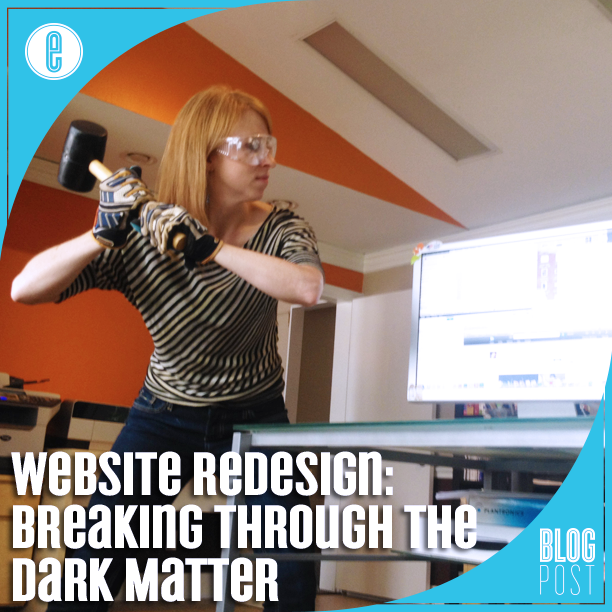
According to scientists, 96% of the universe is composed of dark energy and matter. Yet the 4% we know seems to expand in every direction limitlessly.
Navigating the Internet often feels the same way – a venture into a vast unknown. There are ways to break through the dark matter and up to the virtual surface. One of the best ways to capture your audience’s limited attention is through website redesign.
Before beginning a website redesign, there are some questions your brand should address to make sure this is the right approach for you. Why do people choose to redesign?
 As we’ve all seen, the Internet has sped time up considerable. You swear it was just yesterday that Adobe sent you an update and BAM, new update this morning. Because the Internet is an easy outlet to deliver content to the masses (versus physical storefronts, for example), competition keeps growing. Things like design and content get old fast.
As we’ve all seen, the Internet has sped time up considerable. You swear it was just yesterday that Adobe sent you an update and BAM, new update this morning. Because the Internet is an easy outlet to deliver content to the masses (versus physical storefronts, for example), competition keeps growing. Things like design and content get old fast.
But make sure your web design isn’t just a remedy for low content. Ideally, your website will be updated regularly with new content, giving reasons for your brand to return often. This boosts SEO, and showcases that your brand is adaptable, current, and a player in its industry. SEO is going to influence how important the user perceives your brand to be as well.
Website redesign offers a clean slate to provide the optimal user experience. If your website was created before the smartphone boom, then a redesign is a must. Content should be deliverable, and when website take too long to load or waste data on mobile technology, then you risk losing users. Your website should be interactive (i.e. usable and adaptable). Other experts suggest redesigning the look of a website at least every three years and revamping the complete layout every five years.
Here are some tools and tips for an amazing website redesign:
1. Use Google Analytics or Yahoo! Analytics to determine how users are interacting with your site.
Ideally, users will find value in your offerings and navigate past the home page. If this isn’t the case, your redesign should address sany underlying issues.
2. Hire a developer.
CMS’s (content management systems) are very popular platforms for websites because they allow for constant updates and changes to content. Furthermore, CMS’s alerts you to broken links and error messages on your website, ensuring that your website is a happy ecosystem of user-friendliness.
3. Create a Sitemap
A sitemap wil guide you and your developers through the process, much as the site should guide users through their experience with your brand. The sitemap lays out how content imagery is organized (keep it simple, but informative; more Normal Rockwell than Picasso). Always remember to consider your user’s interests and needs; guide them towards what they want and they will come back for more.
4. Be Mindful of SEO
With a website design, your rankings might shift, but you can take care of this by planning ahead. For instance, try to maintain the old sites’ title tags and meta-descriptions and hold onto old URL’s if possible. Another important tactic is to use a 301 redirect on any pages that have moved.
5. Make Sure all Content is Up-to-Date
Maybe you like doing things the old-fashioned way, but if your contact information is in Morse code, it might be time for an update.
6. Hide Live Changes
Create a subdomain or development site to hide live changes, even if you secretly want the users to uncover those flirtatious notes to your designer.
7. Stay on Brand, and Be User-Friendly
Don’t make your website so drastically different that you can’t recognize site or the brand. You will want web safe fonts and a well contrasted and consistent color scheme. Nothing too dark or light.
8. Website Design is Marketing
Always remember that any interaction with a brand is a form of marketing. Website design and content updates should be a major aspect tof any brand’s marketing strategy. The idea is to get the user engaged and maintain that level of engagement with ease of use and consistent value.
Are you considering a web design or redesign?
The effort poses many questions: What will make my site better and more effective? What do I absolutely need to take into account for my end users? Are there serious SEO issues or new search engine rules that I should watch out for? The following free eBook answers the most crtical questions related to a successful web redesign project:
- Key elements and features “must-haves” for your homepage.
- Critical steps to protect your SEO and content during a site redesign.
- Steps you can take to improve your site right now while the redesign project is underway.
-FINAL(01-00)-White&Blue-01.svg)




